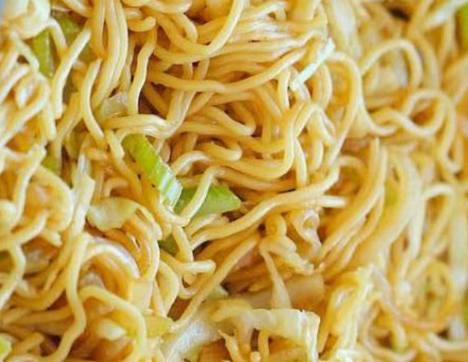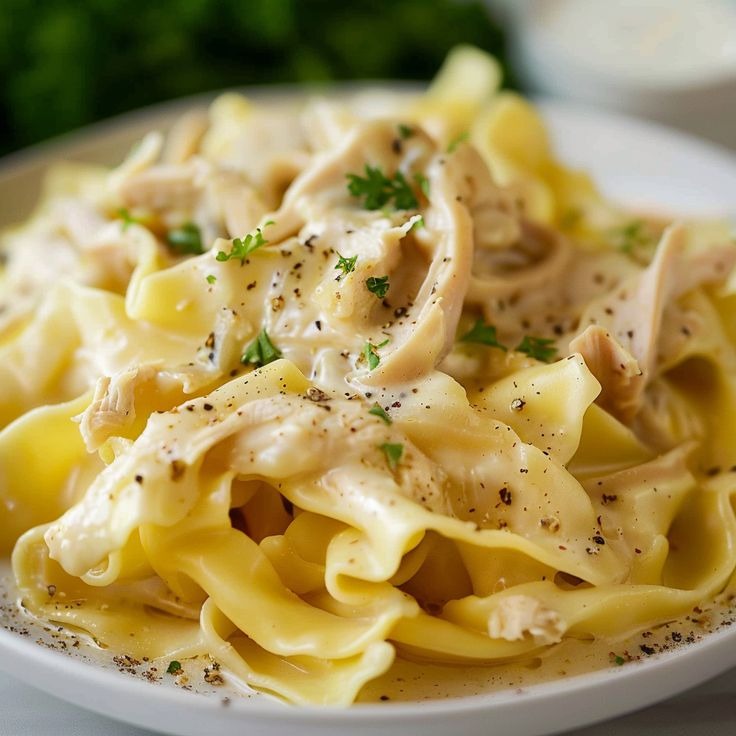Last fall, I was invited to teach a weekend workshop in a small town about two hours from where I live. The town was quiet, warm in spirit, and had a strip mall that held the only few takeout options nearby. After the final class wrapped up and I was running low on energy, I wandered into a small Panda Express tucked between a gas station and a pharmacy.
At first, I just wanted something quick. But then I saw the glistening tray of chow mein in the buffet line—steaming, tangled noodles with sautéed cabbage and onions, coated in that deep umami sauce. It was comforting and salty with just enough bite in the vegetables to keep things interesting. I didn’t realize until then how much I missed that kind of simple, savory food.
Back home the next week, I recreated it in my own kitchen—making it just a touch lighter for everyday cooking, but keeping the flavor true to what made me love it in the first place.
This Panda Express Chow Mein Copycat recipe became an instant favorite, and now it’s a weeknight staple for my family.

Short Description
A quick and savory homemade version of the popular Panda Express Chow Mein—tossed yakisoba noodles with stir-fried cabbage, celery, onions, and a rich, flavorful sauce that’s better than takeout.
Key Ingredients
- 2 packages Yakisoba noodles (about 14 oz each), discard seasoning packets
- 1/4 cup vegetable oil
- 1 small onion, thinly sliced
- 3 stalks celery, chopped
- 4 cups cabbage, shredded
- 3 cloves garlic, minced
- 1/4 cup soy sauce
- 1 tablespoon oyster sauce
- 1 tablespoon sugar
- 1/2 teaspoon sesame oil
- Salt and pepper, to taste
Tools Needed
- Large skillet or wok
- Mixing bowl
- Tongs or spatula
- Knife and cutting board
- Measuring spoons and cups
Cooking Instructions
Step 1: Prepare the Noodles
If using fresh yakisoba noodles, rinse them under warm water to loosen and separate. If using dry noodles, cook them according to the package directions, then drain and set aside. Make sure the noodles aren’t clumped—toss gently in a teaspoon of oil if needed.
Step 2: Cook the Vegetables
Heat the vegetable oil in a large skillet or wok over medium-high heat. Once the oil shimmers, add sliced onion, chopped celery, and shredded cabbage. Stir-fry for 3–4 minutes until the vegetables are slightly tender but still have a crunch. Add the minced garlic and sauté for an additional minute until fragrant.
Step 3: Make the Sauce
In a small bowl, whisk together the soy sauce, oyster sauce, sugar, and sesame oil. Stir until sugar dissolves completely. The sauce should be deep brown, slightly glossy, and balanced between salty and slightly sweet.
Step 4: Combine Noodles and Sauce
Add the noodles to the skillet with the sautéed vegetables. Pour the sauce over the noodles and use tongs to gently toss everything together. Stir-fry for 2–3 minutes until the noodles are evenly coated and heated through.
Step 5: Season and Serve
Taste and adjust seasoning with salt and pepper if needed. Serve the chow mein hot—on its own, as a main, or alongside your favorite Asian-inspired dishes.
Why You’ll Love This Recipe
– Fast and easy: Ready in under 30 minutes
– Better than takeout: Less greasy, more flavor
– Budget-friendly: Feeds a family using pantry staples
– Customizable: Add protein or more veggies
– Naturally dairy-free
Mistakes to Avoid & Solutions
1. Overcooking the vegetables
Avoid mushy textures by stir-frying just until crisp-tender. Celery and cabbage should retain some crunch.
2. Skipping the sauce blend
Don’t pour ingredients directly into the pan—mixing the sauce in a bowl ensures balance and even distribution.
3. Not separating noodles
Rinsing yakisoba noodles in warm water helps them loosen. Clumped noodles lead to uneven cooking.
4. Too much oil
Stick to the 1/4 cup of oil. Excess oil will make the dish greasy instead of glossy.
5. Adding garlic too early
Garlic burns quickly. Always add it after the vegetables have cooked down slightly.
Serving and Pairing Suggestions
Serve hot in shallow bowls, garnished with green onions or sesame seeds.
Pair with teriyaki chicken, egg rolls, or tofu for a full meal.
Perfect for meal prep or serving buffet-style at gatherings.
For a low-carb side, enjoy it with a cucumber salad or steamed edamame.
Storage and Reheating Tips
Storage: Let leftovers cool completely, then store in an airtight container in the fridge for up to 4 days.
Reheat on stovetop: Use a nonstick pan over medium heat, with a splash of water to loosen noodles.
Microwave: Reheat in 30-second intervals, stirring in between.
Avoid freezing: Texture of noodles and cabbage changes unfavorably when thawed.
FAQs
1. Can I use other types of noodles?
Yes! Chow mein noodles, ramen, or even spaghetti can work in a pinch—just cook al dente and toss in oil to prevent sticking.
2. What’s a good substitute for oyster sauce?
Try hoisin sauce or vegetarian mushroom stir-fry sauce for a slightly sweeter, umami-rich alternative.
3. Is this recipe vegetarian?
The base recipe contains oyster sauce, which is not vegetarian. Swap it for a vegetarian stir-fry sauce to make it plant-based.
4. How do I add protein?
Add cooked chicken, shrimp, tofu, or scrambled eggs in Step 4. Stir them in just before the noodles.
5. Can I make this gluten-free?
Use gluten-free tamari instead of soy sauce and ensure your oyster sauce alternative is gluten-free.
Tips & Tricks
– Use a hot pan to achieve that slightly smoky, restaurant-style flavor.
– Cut vegetables uniformly for even cooking.
– Prep all ingredients ahead—stir-frying moves fast!
– Add a squeeze of lime juice or a pinch of chili flakes for brightness and heat.
– Leftovers make a great cold noodle salad the next day.
Recipe Variations
1. Spicy Garlic Chow Mein
Add 1–2 teaspoons chili garlic sauce to the stir-fry sauce
Top with crushed red pepper flakes before serving
Use a little extra garlic for a punchier flavor
2. Veggie-Packed Version
Toss in julienned carrots, snow peas, and bell peppers in Step 2
Increase soy sauce slightly to coat the extra volume
3. Chicken Chow Mein
Sauté sliced chicken breast (about 1 lb) in Step 1 before adding vegetables
Remove when cooked and add back with noodles
4. Low-Sodium Version
Use low-sodium soy sauce
Omit added salt and reduce oyster sauce slightly
Final Thoughts
Panda Express Chow Mein at home reminded me how much joy a humble bowl of noodles can bring. The warm tangle of seasoned noodles, combined with the crunch of fresh vegetables and a perfectly balanced sauce, hits all the right notes. Each bite is savory, comforting, and incredibly satisfying without being heavy. This isn’t a flashy dish, but it’s one that keeps showing up in my kitchen again and again because it hits all the right notes—comfort, ease, and flavor. Cooking it feels rhythmic, from the chopping to the tossing to the sizzling heat of the pan.
It’s also the kind of meal that adapts to your mood—light enough for lunch, hearty enough for dinner, and always better the next day. For me, this chow mein holds more than flavor; it carries a memory of a quiet weekend, unexpected comfort food, and the joy of bringing that moment back home, one noodle at a time.

Ingredients
- 2 packages Yakisoba noodles (about 14 oz each), discard seasoning packets
- 1/4 cup vegetable oil
- 1 small onion, thinly sliced
- 3 stalks celery, chopped
- 4 cups cabbage, shredded
- 3 cloves garlic, minced
- 1/4 cup soy sauce
- 1 tablespoon oyster sauce
- 1 tablespoon sugar
- 1/2 teaspoon sesame oil
- Salt and pepper, to taste
Instructions
Step 1: Prepare the Noodles
Loosen fresh yakisoba noodles with warm water or cook dry noodles per package directions. Drain and separate—toss with a little oil if they stick.
Step 2: Cook the Vegetables
Sauté onion, celery, and cabbage in hot oil for 3–4 minutes until slightly tender. Add garlic and cook for another minute until fragrant.
Step 3: Make the Sauce
Whisk soy sauce, oyster sauce, sugar, and sesame oil in a small bowl until smooth and well combined.
Step 4: Combine Noodles and Sauce
Add noodles and sauce to the skillet. Toss everything gently and stir-fry for 2–3 minutes until well coated and heated through.
Step 5: Season and Serve
Adjust seasoning with salt and pepper to taste. Serve hot as a main or side dish.


